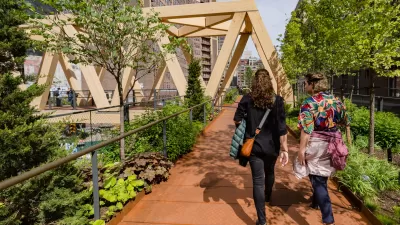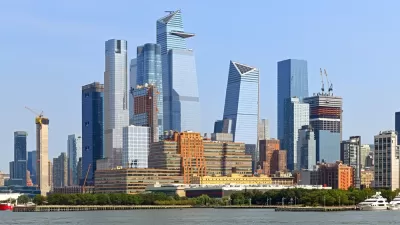New York Times Architecture Critic Michael Kimmelman reviews the third phase of the High Line, which opened September 21, 2014.
The gist of Michael Kimmelman's New York Times review: "If the newest, last stretch of the High Line doesn’t make you fall in love with New York all over again, I really don’t know what to say."
Here is a sampling of the review's sweeping statements about the High Line, its impact on the city, and the soon-to-be-overhauled neighborhood the third phase of the park will weave itself through:
- "But this third phase completes a kind of narrative, which the two earlier phases started, about 21st-century New York as a greener, sleeker metropolis, riven by wealth, with an anxious eye in the rearview mirror. It is a Rorschach test, signifying different things — about urban renewal, industry, gentrification, the environment — to different people."
- "James Corner Field Operations designed the High Line with Diller Scofidio & Renfro. Mr. Corner calls the city around the park its “borrowed landscape.” The inimitability of those surroundings, and the park’s site-specific detailing, are major reasons the so-called High Line effect has been, like the Bilbao one, fool’s gold for so many other cities that have wanted to follow in New York’s footsteps."
- "The designers avoided pressure to top themselves with the third section, and went the other way. A simple shift in orientation of the planks, where two benches crisscross, suffices to signal the High Line’s turn from north-south to east-west. The turn opens onto a wide plaza, the park’s new crossroad, with stairs connecting to Hudson Yards and what will be Hudson Park and Boulevard beyond."
- "With more limited construction funds, the strategy in this part of the park was bare bones: Rusty tracks are filled in with bonded gravel to make a level path; timber dunnage is stacked to make a bleacher from which people can peer out at the water and over the rail yards; and nature is left to its own devices, giving visitors a glimpse of how the High Line looked before its makeover."
FULL STORY: The Climax in a Tale of Green and Gritty

Alabama: Trump Terminates Settlements for Black Communities Harmed By Raw Sewage
Trump deemed the landmark civil rights agreement “illegal DEI and environmental justice policy.”

Study: Maui’s Plan to Convert Vacation Rentals to Long-Term Housing Could Cause Nearly $1 Billion Economic Loss
The plan would reduce visitor accommodation by 25% resulting in 1,900 jobs lost.

Planetizen Federal Action Tracker
A weekly monitor of how Trump’s orders and actions are impacting planners and planning in America.

Wind Energy on the Rise Despite Federal Policy Reversal
The Trump administration is revoking federal support for renewable energy, but demand for new projects continues unabated.

Passengers Flock to Caltrain After Electrification
The new electric trains are running faster and more reliably, leading to strong ridership growth on the Bay Area rail system.

Texas Churches Rally Behind ‘Yes in God’s Back Yard’ Legislation
Religious leaders want the state to reduce zoning regulations to streamline leasing church-owned land to housing developers.
Urban Design for Planners 1: Software Tools
This six-course series explores essential urban design concepts using open source software and equips planners with the tools they need to participate fully in the urban design process.
Planning for Universal Design
Learn the tools for implementing Universal Design in planning regulations.
Caltrans
Smith Gee Studio
Institute for Housing and Urban Development Studies (IHS)
City of Grandview
Harvard GSD Executive Education
Toledo-Lucas County Plan Commissions
Salt Lake City
NYU Wagner Graduate School of Public Service




























